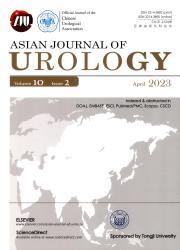前列腺特异性膜抗原-体层正电子发射断层扫描/磁共振成像和前列腺健康指数的组合与各自单独使用在前列腺癌早期诊断中的诊断价值比较
IF 2.4
3区 医学
Q2 UROLOGY & NEPHROLOGY
引用次数: 0
摘要
目的 本研究旨在探讨前列腺健康指数(PHI)和前列腺特异性膜抗原(PSMA)-PET/MR联合使用是否能比单独使用每种方法提高前列腺癌(PCa)的诊断准确性。方法 在这项前瞻性观察研究中,共纳入了41名在2019年6月至2022年9月期间接受系统性前列腺活检的患者。活检前进行 PHI 检测和 18F-PSMA-1007-PET/MR 检测。通过逻辑回归、接收者操作特征曲线下面积(AUC)和净再分类指数(NRI)比较了不同模型的诊断准确性。PCa 组的 PHI 明显高于良性组(44.4 对 35.0,P=0.048)。同样,PCa 组所有患者的 18F-PSMA-1007-PET/MR 结果均为阳性,其中阳性率明显高于良性组(100% 对 62.96%,P=0.025)。18F-PSMA-1007-PET/MR为PHI提供了额外的诊断价值(AUC:0.802 vs. 0.692,p=0.025)。然而,组合模型与单独使用 18F-PSMA-1007-PET/MR 没有明显差异(AUC 0.802 vs. 0.685,p=0.071)。联合模型的最佳 PHI 临界值为 32,该模型可显著减少不必要的活检(NRI:22.22%,95% 置信区间:6.54%-37.90%,P=0.005)。结论 PHI 和 18F-PSMA-1007-PET/MR 的组合在预测 PCa 方面优于单用 PHI,尤其是在避免不必要的活检方面。然而,对于 PHI≥43.5 的患者,在 PHI 的基础上增加 18F-PSMA-1007-PET/MR 并不能带来额外的益处。本文章由计算机程序翻译,如有差异,请以英文原文为准。
Diagnostic value comparison of the combination of prostate-specific membrane antigen-body PET/MR and the prostate health index with each alone in early diagnosis of prostate cancer
Objective
This study aimed to figure out whether the combination of the prostate health index (PHI) and prostate-specific membrane antigen (PSMA)-PET/MR could improve the diagnostic accuracy for prostate cancer (PCa) than that of each individual method used alone.
Methods
In this prospective, observational study, 41 patients who underwent the systematic prostate biopsy between June 2019 and September 2022 were enrolled. Both the PHI test and 18F-PSMA-1007-PET/MR were performed prior to biopsies. The diagnostic accuracy of different models was compared by logistic regression, areas under the curve (AUCs) of the receiver operating characteristic, and net reclassification index (NRI).
Results
Among the 41 patients, 14 (34.1%) were pathologically diagnosed with PCa. The PHI in the PCa group was significantly higher than that in the benign group (44.4 vs. 35.0, p=0.048). Similarly, all the patients in the PCa group received positive results of 18F-PSMA-1007-PET/MR, of which the positive rate was significantly higher than that in benign group (100% vs. 62.96%, p=0.025). The 18F-PSMA-1007-PET/MR provided additional diagnostic values to the PHI (AUC: 0.802 vs. 0.692, p=0.025). However, there was no significant difference between the combination model and the 18F-PSMA-1007-PET/MR alone (AUC 0.802 vs. 0.685, p=0.071). The optimal PHI cutoff of the combination model is 32, with which the model could significantly reduce unnecessary biopsies (NRI: 22.22%, 95% confidence interval: 6.54%–37.90%, p=0.005). However, among patients with the PHI of ≥43.5, there was no significant difference between the combination model and the PHI alone (NRI: 11.11%, 95% confidence interval: −0.74%–22.97%, p=0.066).
Conclusion
The combination of the PHI and 18F-PSMA-1007-PET/MR outperforms the PHI alone for predicting PCa, especially in avoiding unnecessary biopsies. However, for patients with the PHI of ≥43.5, the addition of 18F-PSMA-1007-PET/MR to the PHI does not yield additional benefits.
求助全文
通过发布文献求助,成功后即可免费获取论文全文。
去求助
来源期刊

Asian Journal of Urology
UROLOGY & NEPHROLOGY-
CiteScore
4.00
自引率
3.80%
发文量
100
审稿时长
4 weeks
期刊介绍:
Asian Journal of Urology (AJUR), launched in October 2014, is an international peer-reviewed Open Access journal jointly founded by Shanghai Association for Science and Technology (SAST) and Second Military Medical University (SMMU). AJUR aims to build a communication platform for international researchers to effectively share scholarly achievements. It focuses on all specialties of urology both scientifically and clinically, with article types widely covering editorials, opinions, perspectives, reviews and mini-reviews, original articles, cases reports, rapid communications, and letters, etc. Fields of particular interest to the journal including, but not limited to: • Surgical oncology • Endourology • Calculi • Female urology • Erectile dysfunction • Infertility • Pediatric urology • Renal transplantation • Reconstructive surgery • Radiology • Pathology • Neurourology.
 求助内容:
求助内容: 应助结果提醒方式:
应助结果提醒方式:


